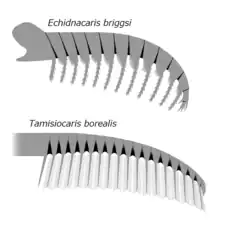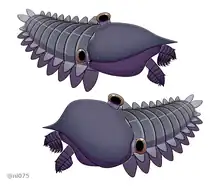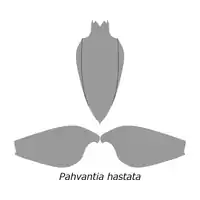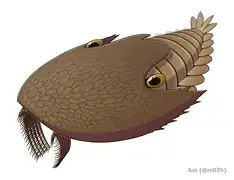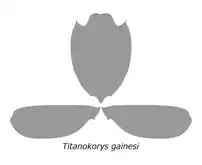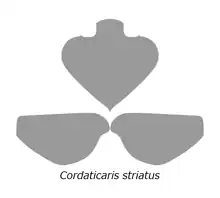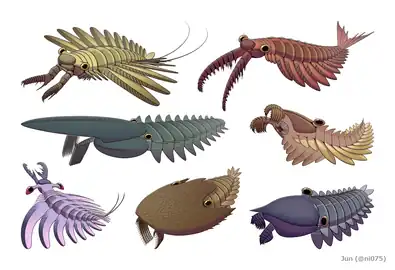Hurdiidae
Hurdiidae is an extinct cosmopolitan family of radiodonts, a group of stem-group arthropods, which lived during the Paleozoic Era. It is the most long-lived radiodont clade, lasting from the Cambrian period to the Devonian period.
| Hurdiidae Temporal range: | |
|---|---|
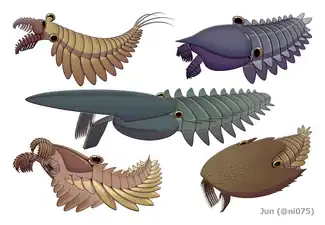 | |
| Stanleycaris (top left), Hurdia (top right), Aegirocassis (middle), Peytoia (bottom left), Cambroraster (bottom right) | |
| Scientific classification | |
| Domain: | Eukaryota |
| Kingdom: | Animalia |
| Phylum: | Arthropoda |
| Class: | †Dinocaridida |
| Order: | †Radiodonta |
| Family: | †Hurdiidae Vinther et al., 2014 |
| Genera | |
|
See text | |
Description
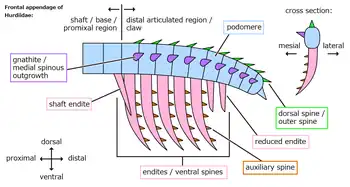
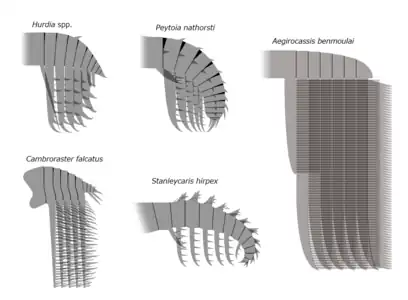
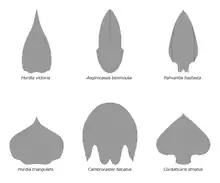
Hurdiidae is characterized by frontal appendages with distal region composed of 5 subequal blade-like endites, alongside the enlarged head carapaces and tetraradial mouthpart (oral cone).[1]
The frontal appendages of hurdiids have a distinctive morphology, with the appendage of most species bearing five equally-sized elongate blade-like ventral spines known as endites.[2] Subsequent podomeres were reduced in size and with only small endites or none. Each podomere bore only a single endite, unlike other radiodonts, in which the endites were paired.[2] In most species, the endites were curved medially, so that the appendages formed a basket-like structure.[1] Some hurdiids had greater numbers of endites, with Cordaticaris bearing seven endites of equal length.[3] Ursulinacaris is unique among hurdiids in bearing paired endites, which is likely a transitional form between the appendage of other radiodonts and that of hurdiids.[2]
Hurdiids exhibited a wide range of body size. The smallest known hurdiid specimen, of an unnamed species, is estimated to have had a body length of 6–15 millimetres (0.24–0.59 in), but it is not known whether this specimen was juvenile or adult.[4] Aegirocassis, the largest known hurdiid, was over 2 metres (6.6 ft) long, comparable in size to the largest known arthropods.[5]
Paleobiology
The majority of hurdiids appear to have been predators that fed by sifting sediment with their frontal appendages, but Aegirocassis was a suspension feeder.[1]
Distribution
Hurdiids had a global distribution.[3] The earliest known hurdiid in the fossil record is Peytoia infercambriensis, which lived during the third age of the Cambrian in what is now the country of Poland.[6] The group increased in diversity during the Miaolingian epoch.[3] Post-Cambrian records of the group are rare, but the group lasted into the Devonian period, with the last known taxon being the Emsian Schinderhannes bartelsi from what is now Germany.[6][4]
Classification
Hurdiidae is classified within Radiodonta, a clade of stem-group arthropods. Hurdiidae is defined phylogenetically as the most inclusive clade containing Hurdia victoria but not Amplectobelua symbrachiata, Anomalocaris canadensis, or Tamisiocaris borealis.[7]
The phylogeny of hurdiids, accompanying the description of the hurdiids Aegirocassis benmoulae, Titanokorys gainesii, and the analyzation of Stanleycaris hirpex as follows:[5]
| |||||||||||||||||||||||||||||||||||||||||||||||||||||||||||||||
| Phylogenetic position of hurdiid radiodonts after Moysiuk & Caron 2022.[8] |
Species include
- Buccaspinea cooperi[9]
- Cambroraster falcatus[10]
- Cordaticaris striatus[10]
- Hurdia triangulata[10]
- Hurdia victoria[10]
- Pahvantia hastata[10]
- Peytoia nathorsti[10]
- Peytoia infercambriensis[2]
- Schinderhannes bartelsi[10]
- Stanleycaris hirpex[10]
- Titanokorys gainesii[10]
- Ursulinacaris grallae[2]
- Zhenghecaris shankouensis[10]
- Aegirocassisinae
References
- Moysiuk, J.; Caron, J.-B. (2019-08-14). "A new hurdiid radiodont from the Burgess Shale evinces the exploitation of Cambrian infaunal food sources". Proceedings of the Royal Society B: Biological Sciences. 286 (1908): 20191079. doi:10.1098/rspb.2019.1079. PMC 6710600. PMID 31362637.
- Pates, Stephen; Daley, Allison C.; Butterfield, Nicholas J. (2019). "First report of paired ventral endites in a hurdiid radiodont". Zoological Letters. 5 (1): 18. doi:10.1186/s40851-019-0132-4. ISSN 2056-306X. PMC 6560863. PMID 31210962.
- Sun, Zhixin; Zeng, Han; Zhao, Fangchen (2020). "A new middle Cambrian radiodont from North China: Implications for morphological disparity and spatial distribution of hurdiids". Palaeogeography, Palaeoclimatology, Palaeoecology. 558: 109947. Bibcode:2020PPP...558j9947S. doi:10.1016/j.palaeo.2020.109947. ISSN 0031-0182. S2CID 224868404.
- Pates, Stephen; Botting, Joseph P.; McCobb, Lucy M. E.; Muir, Lucy A. (2020). "A miniature Ordovician hurdiid from Wales demonstrates the adaptability of Radiodonta". Royal Society Open Science. 7 (6): 200459. Bibcode:2020RSOS....700459P. doi:10.1098/rsos.200459. PMC 7353989. PMID 32742697.
- Van Roy, Peter; Daley, Allison C.; Briggs, Derek E. G. (2015). "Anomalocaridid trunk limb homology revealed by a giant filter-feeder with paired flaps". Nature. 522 (7554): 77–80. Bibcode:2015Natur.522...77V. doi:10.1038/nature14256. PMID 25762145. S2CID 205242881.
- Daley, Allison C.; Legg, David A. (2015). "A morphological and taxonomic appraisal of the oldest anomalocaridid from the Lower Cambrian of Poland". Geological Magazine. 152 (5): 949–955. Bibcode:2015GeoM..152..949D. doi:10.1017/S0016756815000412. S2CID 130745134.
- Vinther, Jakob; Stein, Martin; Longrich, Nicholas R.; Harper, David A. T. (2014). "A suspension-feeding anomalocarid from the Early Cambrian" (PDF). Nature. 507 (7493): 496–499. Bibcode:2014Natur.507..496V. doi:10.1038/nature13010. PMID 24670770. S2CID 205237459.
- Moysiuk, Joseph; Caron, Jean-Bernard (2022-07-08). "A three-eyed radiodont with fossilized neuroanatomy informs the origin of the arthropod head and segmentation". Current Biology. 32 (15): 3302–3316.e2. doi:10.1016/j.cub.2022.06.027. ISSN 0960-9822. PMID 35809569. S2CID 250361698.
- Pates S, Lerosey-Aubril R, Daley AC, Kier C, Bonino E, Ortega-Hernández J. 2021. The diverse radiodont fauna from the Marjum Formation of Utah, USA (Cambrian: Drumian) PeerJ 9:e10509 https://doi.org/10.7717/peerj.10509
- Caron, Jean-Bernard; Moysiuk, Joe (2021). "A giant nektobenthic radiodont from the Burgess Shale and the significance of hurdiid carapace diversity". R. Soc. Open Sci. 8 (210664): 210664. doi:10.1098/rsos.210664. PMC 8424305. PMID 34527273.
- Potin, G. J.-M.; Gueriau, P.; Daley, A. C. (2023). "Radiodont frontal appendages from the Fezouata Biota (Morocco) reveal high diversity and ecological adaptations to suspension-feeding during the Early Ordovician". Frontiers in Ecology and Evolution. 11. 1214109. doi:10.3389/fevo.2023.1214109.
